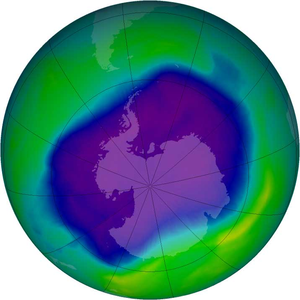
- Image via Wikipedia
Slate Magazine’s environmental section, The Green Lantern, published an article a few days ago that dug out a topic that many of us probably have forgotten about: the ozone layer, a gas shield that protects us from the sun’s harmful UV-B rays located roughly six to 30 miles above the Earth’s surface. The topic made headlines in the 1980s and although it hasn’t exactly been forgotten about, it’s not longer a hot media topic either, having been replaced by climate change. But the problem hasn’t gone away; in fact the hole is bigger than before, spanning “a patch of sky almost the size of North Americaâ€.
The situation could be worse, though. Actions taken 20 years ago means that the widening of the hole slowed down. Also, it takes a long time for the ozone layer to heal as some of the banned ozone-destroying gases are still floating around the atmosphere. But upon noticing the use of the verb ‘heal’ I got thinking: is there a chance that the ozone layer will patch itself up?
Science Daily reported a couple of weeks ago that scientists “found a global slightly positive trend of ozone increase of almost 1% per decade in the total ozone from the last 14 years: a result that was confirmed by comparisons with ground-based measurementsâ€.
So, yes, it seems that the Montreal Protocol, a 1987 agreement that calls for a ban on producing and using nearly 100 of the most important ozone-depleting chemicals, and which recently was ratified by every member of the United Nations, is yielding some results.
The problem is that some of the replacement gases actually cause global warming.
Still according to the Lantern, “the hydrofluorocarbons (HFCs) we use in place of many CFCs [chlorofluorocarbon; a class of chemical compounds that deplete ozone] don’t contribute to ozone depletion, but some of them have thousands of times the global warming potential of carbon dioxide.†These chemicals are used in refrigerators and air conditioners, domestic goods that have become increasingly disposable, a consumer plague.
So be sure to avoid HFCs as much as you can as there are more eco-friendly options out there. Surely we want to protect the ozone layer and not contribute to global warming at the same time.

![Reblog this post [with Zemanta]](https://img.zemanta.com/reblog_e.png?x-id=9e452e2f-0b78-44e6-b1da-690ec1a36726)





3 Comments